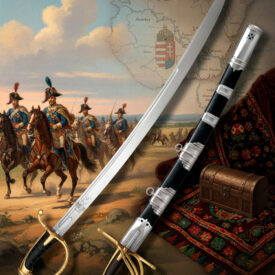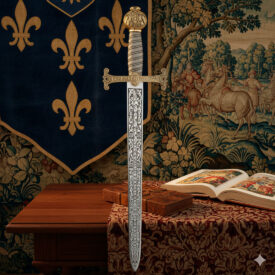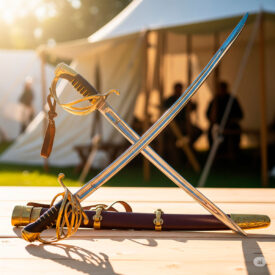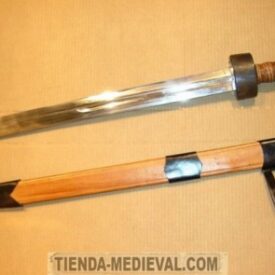Have you ever wondered if that antique saber, passed down through generations, could be an authentic relic from the Napoleonic Wars? Behind the gleam of every blade lies a story, a legacy that transports you to the battlefields where military cunning forged an empire. Discover with this guide how to differentiate a collector’s item from a mere imitation.
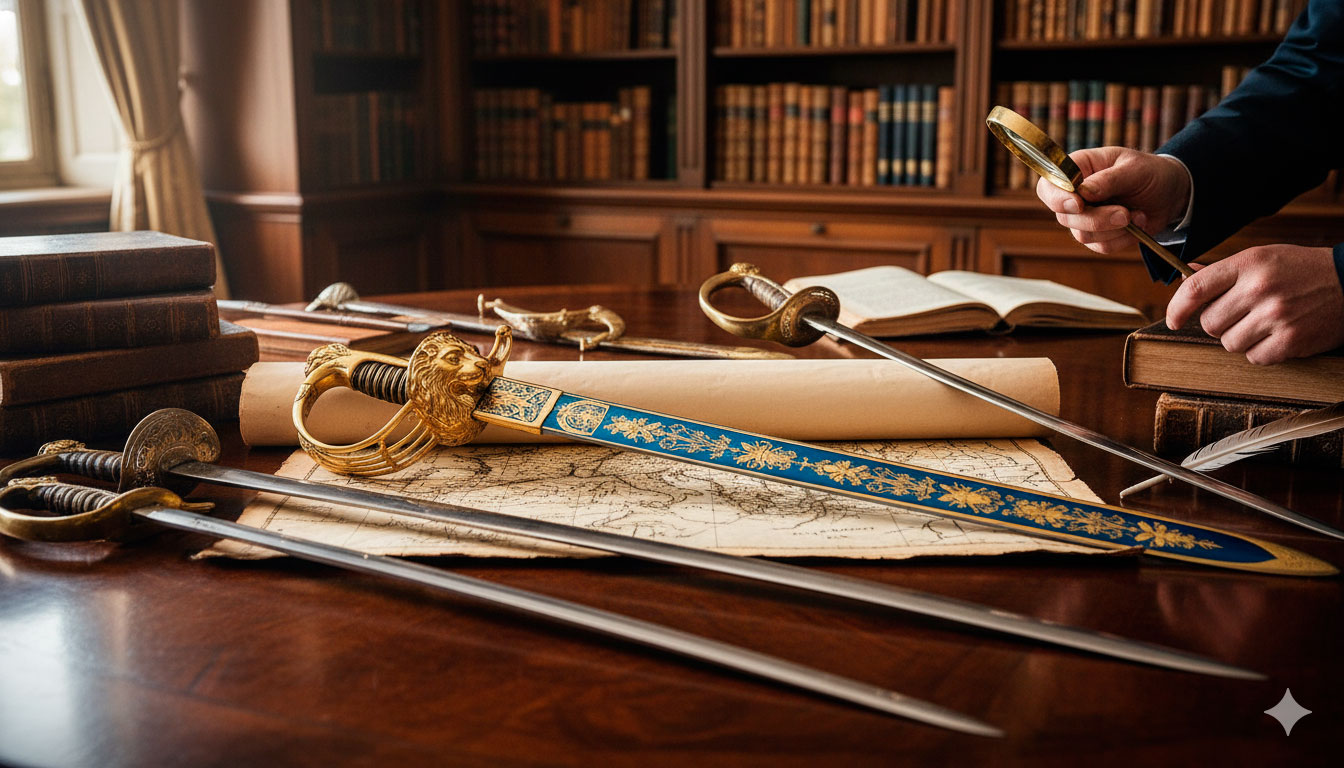
Napoleon’s Personal Sabers: A Link to History
Napoleon Bonaparte, one of history’s most influential figures, wielded several sabers that became symbols of his rise and campaigns. These weapons, beyond their military function, were extensions of his power and legacy. Delving into his personal pieces allows us to understand the artisanal mastery and symbolism of an era.
| Nomenclature/Context | Historical Use | Distinctive Features and Manufacturing |
|---|---|---|
| Italian Campaign Saber (General) | Used as a general in the Italian campaigns (possibly 1798), where he gained glory and respect. | Features a gilded stirrup guard, chiselled with stylized plants, a fluted pommel, and a black ebony grip. The blade is curved, damascened, and blued, possibly Ottoman or Egyptian craftsmanship. It is decorated with a Mamluk bust with gilding and an inscription with a crested helmet, cannonballs, and a drum. Manufactured in Versailles by Nicolás Noel Boutet. |
| Boulogne Camp Sword (Consul for Life) | Used in the Boulogne camps while preparing for the invasion of England. | Sword with a stirrup guard, characterized by having five balls on both the guard and the shell, a typical English style fashionable in France at that time. The shell is pierced with the naked figure of the god Mars. The blade is straight, blue in its first part, and engraved in gold with ancient trophies. |
| Austerlitz Sword (Emperor) | Used in the Battle of Austerlitz (1805), his most famous battle, also known as the Battle of the Three Emperors. It is considered his most unique and prestigious piece. | It is an entirely gilded piece. The hilt is gold, with chiselled and engraved bas-reliefs. On the turned shell, it features Napoleon’s bust among laurels. The pommel has a helmet among laurels; on the grip, the profiles of Hercules and Alexander the Great are visible. The blade is straight, damascened, and decorated in blue and gold. An inscription added in 1896 by Biennais identifies it. |
| St. Helena Saber (Exile) | Possibly his favorite piece, he took it with him to his captivity on the island of St. Helena until his death in 1821. | Features a “Turkish-style” hilt. The grip ends with a distinctive harnessed horse’s head, connecting the straight quillons with a small chain. The blade is curved and bears the Sollingen mark. It stands out for an Arabic inscription, clumsily engraved, which reads: “You will annihilate your enemies and protect the Muslims.” The guard and scabbard are signed by Abraham Tilberg, armorer to the court of Stockholm. |
- Italian Campaign Saber (General)
-
- Historical Use: Used as a general in the Italian campaigns (possibly 1798), where he gained glory and respect.
- Distinctive Features and Manufacturing: Features a gilded stirrup guard, chiselled with stylized plants, a fluted pommel, and a black ebony grip. The blade is curved, damascened, and blued, possibly Ottoman or Egyptian craftsmanship. It is decorated with a Mamluk bust with gilding and an inscription with a crested helmet, cannonballs, and a drum. Manufactured in Versailles by Nicolás Noel Boutet.
- Boulogne Camp Sword (Consul for Life)
-
- Historical Use: Used in the Boulogne camps while preparing for the invasion of England.
- Distinctive Features and Manufacturing: Sword with a stirrup guard, characterized by having five balls on both the guard and the shell, a typical English style fashionable in France at that time. The shell is pierced with the naked figure of the god Mars. The blade is straight, blue in its first part, and engraved in gold with ancient trophies.
- Austerlitz Sword (Emperor)
-
- Historical Use: Used in the Battle of Austerlitz (1805), his most famous battle, also known as the Battle of the Three Emperors. It is considered his most unique and prestigious piece.
- Distinctive Features and Manufacturing: It is an entirely gilded piece. The hilt is gold, with chiselled and engraved bas-reliefs. On the turned shell, it features Napoleon’s bust among laurels. The pommel has a helmet among laurels; on the grip, the profiles of Hercules and Alexander the Great are visible. The blade is straight, damascened, and decorated in blue and gold. An inscription added in 1896 by Biennais identifies it.
- St. Helena Saber (Exile)
-
- Historical Use: Possibly his favorite piece, he took it with him to his captivity on the island of St. Helena until his death in 1821.
- Distinctive Features and Manufacturing: Features a “Turkish-style” hilt. The grip ends with a distinctive harnessed horse’s head, connecting the straight quillons with a small chain. The blade is curved and bears the Sollingen mark. It stands out for an Arabic inscription, clumsily engraved, which reads: “You will annihilate your enemies and protect the Muslims.” The guard and scabbard are signed by Abraham Tilberg, armorer to the court of Stockholm.
The Legendary Marengo Saber: A Priceless Weapon That Forged an Empire
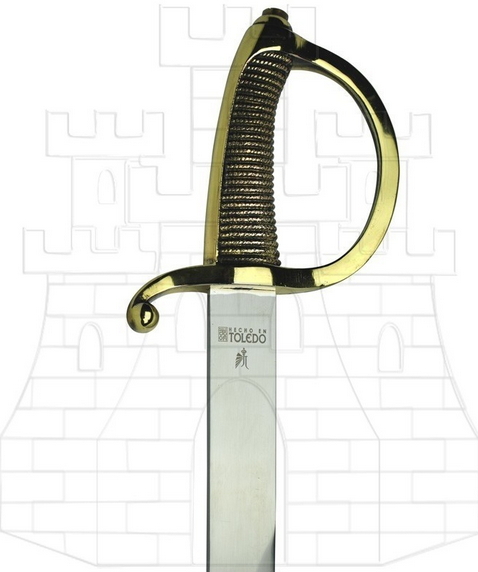
Among all the Emperor’s personal weapons, the Marengo Saber stands out for its immense historical and economic value. Used by Napoleon in the decisive Battle of Marengo in 1800, it was a key instrument in his consolidation as First Consul. This significant piece was auctioned in 2007, reaching the astonishing figure of 4.8 million euros, a world record for a saber and a memento of the Emperor.
The saber, with its curved damascened blade, probably from Solingen and acid-etched, bore an inscription on the scabbard: “Saber of Napoleon the Great at the Battle of Marengo.” Such an evocative piece that, even today, continues to fascinate with its history and its connection to one of the most brilliant military strategists of all time.
A Walk Through History: Chronology of Napoleonic Sabers
The history of Napoleonic sabers is as rich as the battles in which they were wielded. From the early briquets to complex cavalry designs, each weapon reflects the military and cultural evolution of the era. Join us on a journey through the most important events that shaped the design and use of these legendary pieces.
| Era | Event |
|---|---|
| Period of consolidation and initial standard armament | |
| 1767 | Introduction of the short briquet saber in France: effective in hand-to-hand combat and as a camp tool; it would become the quintessential saber of French occupation troops from 1808, and Napoleon would extend its use to line regiments, grenadiers, and artillery. |
| 1769 | Birth of Napoleon Bonaparte. |
| 1797–1798 | Italian Campaigns: Napoleon gifts around a hundred sabers to his heroes (practice in 1797 and 1798). Piece A: saber with stirrup guard, curved damascened blade (probably Ottoman or Egyptian) decorated with crescent moons, suns, and a Mamluk bust. |
| 1799 (November) | Coup of 18 Brumaire: consolidation as First Consul. The Marengo saber becomes associated with the beginning of his power after the coup. |
| 1800 (June 14) | Battle of Marengo: Napoleon uses the famous Marengo saber, made by the Versailles manufactory and designed by Nicolas-Noël Boutet; curved damascened blade (possible origin from Solingen). |
| 1800 (Year IX) | Introduction of the AN IX Model saber for heavy cavalry: straight and flat blade; troops complained about its excessive weight. |
| 1800–1802 | Boulogne Camps (preparation for the invasion of England): Napoleon uses a sword (piece B) with a stirrup guard featuring five balls on both the guard and the shell (a typical English trait); straight blade. During this period, Napoleon is Consul for Life. |
| 1802 (Year XI) | Introduction of the AN XI Model saber (heavy and light cavalry): modification of the straight blade incorporating four fullers (grooves) to lighten it while maintaining rigidity; it becomes a key pattern for light cavalry. |
| 1803 (Great Britain) | A saber pattern for infantry officers inspired by the 1796 light cavalry saber is authorized in Great Britain. |
| 1804 (Year XIII) | Proclamation of Napoleon as Emperor. Introduction of the AN XIII Model saber (heavy cavalry): refinement of the AN XI, with variations in the guard; it becomes standard for the Cuirassiers. |
| Imperial period, ceremonial use, and decline | |
| December 2, 1805 | Battle of Austerlitz: Napoleon uses a highly prestigious sword (piece C) — entirely gilded, straight blade — whose turned shell shows Napoleon’s bust among laurels. |
| 1806 | The briquet saber is officially named in France (although it existed since 1767). It is a short saber (≈75 cm) with a curved blade (≈59 cm); collectors call it M1806 for its use in the Napoleonic army. |
| October 7, 1807 | Imperial decree restricting the use of the briquet saber in the infantry to non-commissioned officers, grenadiers, carabiniers, and drummers, reflecting standardization and specialization of armament. |
| April 1814 | First abdication of Napoleon: the Manufacture Royale de Klingenthal continues to produce the AN XIII saber under the new “Royal” name, maintaining the same inspectors of the Empire. |
| June 18, 1815 | Battle of Waterloo: end of Napoleon’s power. The British 1796 heavy cavalry saber was used in that conflict; Napoleon is exiled to Saint Helena. |
| 1815–1821 | Captivity on the island of Saint Helena: Napoleon carries the Saint Helena saber (piece D) with him until his death in 1821. Features: a “Turkish-style” hilt, grip ending in a horse’s head, and a curved blade with an Arabic inscription. |
| 1827 | Manufacture of the Old French Sword Model 1816 for artillery non-commissioned officers by the Manufacture Royale de Klingenthal (September 1827). |
| 2007 | Auction of the Marengo saber: sold for 4.8 million euros. |
| 21st Century (current) | Location of personal pieces: Napoleon’s four main pieces (A, B, C, and D) are in the Musée de l’Armée — Les Invalides in Paris, although the Marengo saber was auctioned in 2007. |
Standard Armament of the Grande Armée: The Forging of Imperial Power
The efficiency of Napoleon’s Grande Armée lay not only in his strategic genius but also in the standardization and quality of its weaponry. Each saber, each sword, was designed with a specific purpose, adapted to the needs of each army corps.
The Cavalry: The Edge of Speed and Impact
Napoleonic cavalry was divided into two broad categories, and their sabers reflected this distinction:
| Cavalry Corps | Key Model | Key Technical Characteristics | Dominant Tactic |
|---|---|---|---|
| Heavy Cavalry (Cuirassiers, Carabiniers) | AN XIII (1804), evolution of AN IX and AN XI. | Straight and robust blades, optimized for thrust. AN XI and AN XIII models incorporated four fullers (grooves) in the blade to lighten it and maintain its rigidity. The guard of the AN XIII was directly joined from the pommel. | Shock charge, penetration, and decisive thrust. |
| Light Cavalry (Hussars, Chasseurs) | AN IV / AN XI. | Curved and light blades, with an approximate blade length of 75–82 cm. Design optimized for fast cutting and skirmishing. | Skirmish, reconnaissance, and quick cuts on horseback. |
- Heavy Cavalry (Cuirassiers, Carabiniers)
-
- Key Model: AN XIII (1804), evolution of AN IX and AN XI.
- Key Technical Characteristics: Straight and robust blades, optimized for thrust. AN XI and AN XIII models incorporated four fullers (grooves) in the blade to lighten it and maintain its rigidity. The guard of the AN XIII was directly joined from the pommel.
- Dominant Tactic: Shock charge, penetration, and decisive thrust.
- Light Cavalry (Hussars, Chasseurs)
-
- Key Model: AN IV / AN XI.
- Key Technical Characteristics: Curved and light blades, with an approximate blade length of 75–82 cm. Design optimized for fast cutting and skirmishing.
- Dominant Tactic: Skirmish, reconnaissance, and quick cuts on horseback.
Infantry and Artillery: The Briquet, a Weapon for the Trenches
The Briquet Saber, the standard short saber of the infantry, was an omnipresent weapon in the Napoleonic ranks.
- Use: Adopted by infantry, grenadiers, and artillery, its use was extended by Napoleon to line regiments.
- Function: Designed for hand-to-hand combat and useful in closed formations, the briquet allowed for dangerous thrusts and effective charges.
- Description: A short saber with a curved blade, with a total length of 74 to 78 cm. Its hilt was made of brass and featured the characteristic curved knuckle-bow.
Manufacturing and Status: When the Saber Becomes an Insignia
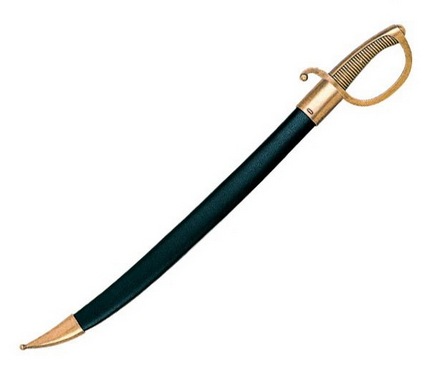 The production of sabers in the Napoleonic era was a symphony of precision and control. State manufactories, such as the famous Klingenthal, were the heart of this industry, where quality was paramount.
The production of sabers in the Napoleonic era was a symphony of precision and control. State manufactories, such as the famous Klingenthal, were the heart of this industry, where quality was paramount.
Quality Control and Traceability
Each blade was subjected to a rigorous quality control system, marked with punches that certified its standard and allowed its production date to be traced. This production infrastructure was so robust that it even transcended regime changes, adapting over time but always maintaining high standards.
The Officer’s Distinction: A Weapon of Prestige
Although regulations sought uniformity, officer’s sabers were an exception. They allowed for a “more elaborate construction,” transforming these weapons into true works of art. With ornamented brass or bronze hilts, often gilded, the officer’s saber was a social insignia that reinforced his authority and status within the empire.
Resolve Your Doubts About Napoleonic Sabers
What are the main differences between light cavalry sabers and heavy cavalry sabers?
The main differences between light cavalry sabers and heavy cavalry sabers are their design, weight, curvature, and combat function.
- Light cavalry sabers: They are lighter, with thinner, narrower blades and a pronounced curvature. They are designed for speed and agility, allowing for quick maneuvers and effective cuts from horseback. Their lighter weight facilitates rapid movements and reconnaissance, making them ideal for quick attacks and harassment.
- Heavy cavalry sabers: They are heavier, more robust, and have wider, less curved blades. They are intended for powerful attacks to break enemy lines, with a design focused on strength and penetration power, suitable for engaging infantry or heavy cavalry. They are less agile but more effective in impact blows.
Light sabers prioritize maneuverability and speed with a more curved and lighter blade, while heavy ones seek power and strength with a wider, heavier, and less curved blade.
What materials were used in the hilts of Napoleonic sabers?
Various materials were used in the hilts of Napoleonic sabers, depending on the rank and function of the weapon.
The most common materials included brass or gilded bronze for the guard and decorative elements. For the grip itself, ivory or covered wood was used, frequently decorated with motifs such as horse heads or other ornaments. In some cases, the grip was also covered with leather and brass wire, particularly in higher-ranking sabers.
In pieces for higher-ranking officers, the hilts could be enriched with gold inlays and personal inscriptions, which distinguished them as prestigious weapons. The guard was usually rounded in briquets (short sabers) and could be reinforced in cavalry sabers.
The structural core was generally made of wood, which provided lightness and resistance, upon which the decorative and functional materials mentioned were applied.
How are authentic Napoleonic saber replicas identified?
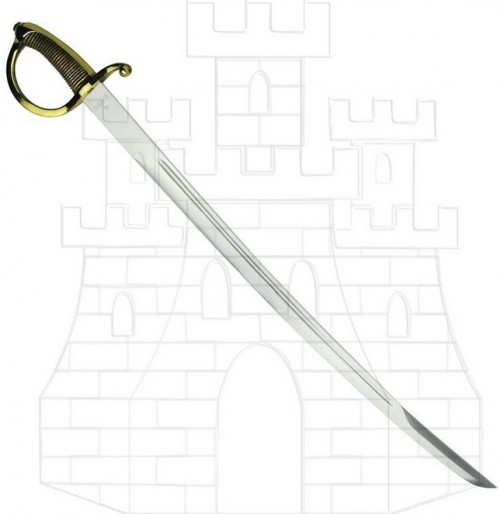 Authentic replicas of Napoleonic sabers are identified by their fidelity to historical models in proportions, design, and finishes. They must feature curved and light blades for light cavalry, or straight and massive blades for heavy cavalry, with closed guards and pronounced knuckle guards for protection. Materials typically include carbon steel or stainless steel, with aged brass hilts and brass or iron scabbards. Authenticity is also verified by balance, weight (between 0.6 and 1.1 kg), the presence of factory marks, and the consistency of decorations with historical patterns.
Authentic replicas of Napoleonic sabers are identified by their fidelity to historical models in proportions, design, and finishes. They must feature curved and light blades for light cavalry, or straight and massive blades for heavy cavalry, with closed guards and pronounced knuckle guards for protection. Materials typically include carbon steel or stainless steel, with aged brass hilts and brass or iron scabbards. Authenticity is also verified by balance, weight (between 0.6 and 1.1 kg), the presence of factory marks, and the consistency of decorations with historical patterns.
What manufacturing techniques were used for Napoleonic sabers?
Napoleonic sabers were manufactured using highly specialized forging techniques that combined art and technical precision.
Steel selection and treatment: The quality of the saber depended fundamentally on the materials used. The best blades were made from Damascus steel or, later, high-quality carbon steel. These materials offered the optimal combination of hardness and flexibility necessary for an effective combat weapon.
Localized tempering: A fundamental technique was the differentiated tempering of the blade. Experienced swordsmiths knew how to temper the blade to be extremely hard at the edge but more flexible towards the spine. This process was crucial to prevent the blade from breaking under high tension during combat. Original blades were produced with localized tempering, which allowed different parts of the blade to have distinct mechanical properties according to their function.
Hilt manufacturing: Hilts were generally made of wood and wrapped with leather or wire to ensure a secure grip. For officer’s sabers, nobler materials such as ivory or mother-of-pearl were used, which added both functionality and social distinction to the weapon.
Scabbards and finishes: Scabbards were entirely made of wood, lined with thick leather, and fitted with hardware. The scabbards were made of brass or iron, often coated for durability and protection.
Marks and personalization: Many pieces bore engravings with the date and manufacturing workshop, allowing their origin to be identified. The most prestigious forging centers such as Klingenthal, Toledo, and French forging centers left their characteristic mark on blades and guards. Blades could carry decorations such as trophies of arms, laurels, and mythological motifs, while high-ranking pieces featured gold inlays or personal inscriptions.
What symbolism did Napoleonic sabers hold at the time?
Napoleonic sabers symbolized honor, distinction, military power, and rank among officers during the Napoleonic era. In addition to being combat weapons, they represented the identity, pride, and authority of the French army, reflected in decorative details such as gilded hilts, laurels, and mythological figures that reinforced the prestige and command of their bearers. They were also a cultural symbol of chivalry, bravery, and military tradition in the context of the campaigns and public image of the time.
The Legacy of the Napoleonic Saber: An Echo Through Time
The sabers and swords of the Napoleonic era are not just historical objects; they are symbols of a time of military and cultural transformation. Their study allows us to understand the evolution of European combat fencing and the sophistication of weapon manufacturing of the era.
Currently, these pieces are highly valued by collectors, and the market for high-quality replicas, manufactured in artisanal centers such as those in Toledo, continues to keep the tradition alive. Even the curious art of “sabrage,” opening a champagne bottle with a saber to celebrate victory, is attributed to Napoleon, demonstrating how these weapons transcended battlefields to become rooted in popular culture.
Throughout history, the Napoleonic saber has illustrated the perfect union between pragmatic military engineering for the troops and the exalted symbolism of officer’s pieces, such as the famous Marengo Saber or the Austerlitz Sword.
